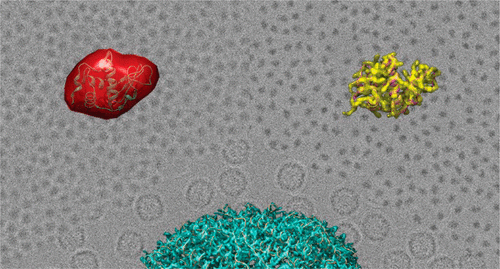当前位置:
X-MOL 学术
›
J. Chem. Inf. Model.
›
论文详情
Our official English website, www.x-mol.net, welcomes your
feedback! (Note: you will need to create a separate account there.)
Could Egg White Lysozyme be Solved by Single Particle Cryo-EM?
Journal of Chemical Information and Modeling ( IF 5.6 ) Pub Date : 2020-03-23 , DOI: 10.1021/acs.jcim.9b01176 Y Zhang 1 , R Tammaro 1 , P J Peters 1 , R B G Ravelli 1
Journal of Chemical Information and Modeling ( IF 5.6 ) Pub Date : 2020-03-23 , DOI: 10.1021/acs.jcim.9b01176 Y Zhang 1 , R Tammaro 1 , P J Peters 1 , R B G Ravelli 1
Affiliation

|
The combination of high-end cryogenic transmission electron microscopes (cryo-EM), direct electron detectors, and advanced image algorithms allows researchers to obtain the 3D structures of much smaller macromolecules than years ago. However, there are still major challenges for the single-particle cryo-EM method to achieve routine structure determinations for macromolecules much smaller than 100 kDa, which are the majority of all plant and animal proteins. These challenges include sample characteristics such as sample heterogeneity, beam damage, ice layer thickness, stability, and quality, as well as hardware limitations such as detector performance, beam, and phase plate quality. Here, single particle data sets were simulated for samples that were ideal in terms of homogeneity, distribution, and stability, but with realistic parameters for ice layer, dose, detector performance, and beam characteristics. Reference data were calculated for human apo-ferritin using identical parameters reported for an experimental data set downloaded from EMPIAR. Processing of the simulated data set resulted in a value of 1.86 Å from 20 214 particles, similar to a 2 Å density map obtained from 29 224 particles selected from real micrographs. Simulated data sets were then generated for a 14 kDa protein, hen egg white lysozyme (HEWL), with and without an ideal phase plate (PP). Whereas we could not obtain a high-resolution 3D reconstruction of HEWL for the data set without PP, the one with PP resulted in a 2.78 Å resolution density map from 225 751 particles. Our simulator and simulations could help in pushing the size limits of cryo-EM.
中文翻译:

单颗粒冷冻电镜可以解决蛋清溶菌酶的问题吗?
高端低温透射电子显微镜 (cryo-EM)、直接电子探测器和先进图像算法的结合使研究人员能够获得比几年前小得多的大分子的 3D 结构。然而,单颗粒冷冻电镜方法要实现远小于 100 kDa 的大分子(所有植物和动物蛋白中的大多数)的常规结构测定仍然面临重大挑战。这些挑战包括样品特征,例如样品异质性、光束损伤、冰层厚度、稳定性和质量,以及硬件限制,例如探测器性能、光束和相位板质量。在这里,对单粒子数据集进行了模拟,以获得在均匀性、分布和稳定性方面理想的样品,但具有冰层、剂量、探测器性能和光束特性的实际参数。使用从 EMPIAR 下载的实验数据集报告的相同参数计算人脱铁铁蛋白的参考数据。对模拟数据集的处理得出 20 214 个颗粒的 1.86 Å 值,类似于从真实显微照片中选择的 29 224 个颗粒获得的 2 Å 密度图。然后生成 14 kDa 蛋白质、鸡蛋清溶菌酶 (HEWL) 的模拟数据集,有或没有理想相位板 (PP)。虽然我们无法获得没有 PP 的数据集的 HEWL 高分辨率 3D 重建,但有 PP 的数据集产生了 225 751 个粒子的 2.78 Å 分辨率密度图。我们的模拟器和模拟可以帮助突破冷冻电镜的尺寸限制。
更新日期:2020-03-23
中文翻译:

单颗粒冷冻电镜可以解决蛋清溶菌酶的问题吗?
高端低温透射电子显微镜 (cryo-EM)、直接电子探测器和先进图像算法的结合使研究人员能够获得比几年前小得多的大分子的 3D 结构。然而,单颗粒冷冻电镜方法要实现远小于 100 kDa 的大分子(所有植物和动物蛋白中的大多数)的常规结构测定仍然面临重大挑战。这些挑战包括样品特征,例如样品异质性、光束损伤、冰层厚度、稳定性和质量,以及硬件限制,例如探测器性能、光束和相位板质量。在这里,对单粒子数据集进行了模拟,以获得在均匀性、分布和稳定性方面理想的样品,但具有冰层、剂量、探测器性能和光束特性的实际参数。使用从 EMPIAR 下载的实验数据集报告的相同参数计算人脱铁铁蛋白的参考数据。对模拟数据集的处理得出 20 214 个颗粒的 1.86 Å 值,类似于从真实显微照片中选择的 29 224 个颗粒获得的 2 Å 密度图。然后生成 14 kDa 蛋白质、鸡蛋清溶菌酶 (HEWL) 的模拟数据集,有或没有理想相位板 (PP)。虽然我们无法获得没有 PP 的数据集的 HEWL 高分辨率 3D 重建,但有 PP 的数据集产生了 225 751 个粒子的 2.78 Å 分辨率密度图。我们的模拟器和模拟可以帮助突破冷冻电镜的尺寸限制。











































 京公网安备 11010802027423号
京公网安备 11010802027423号